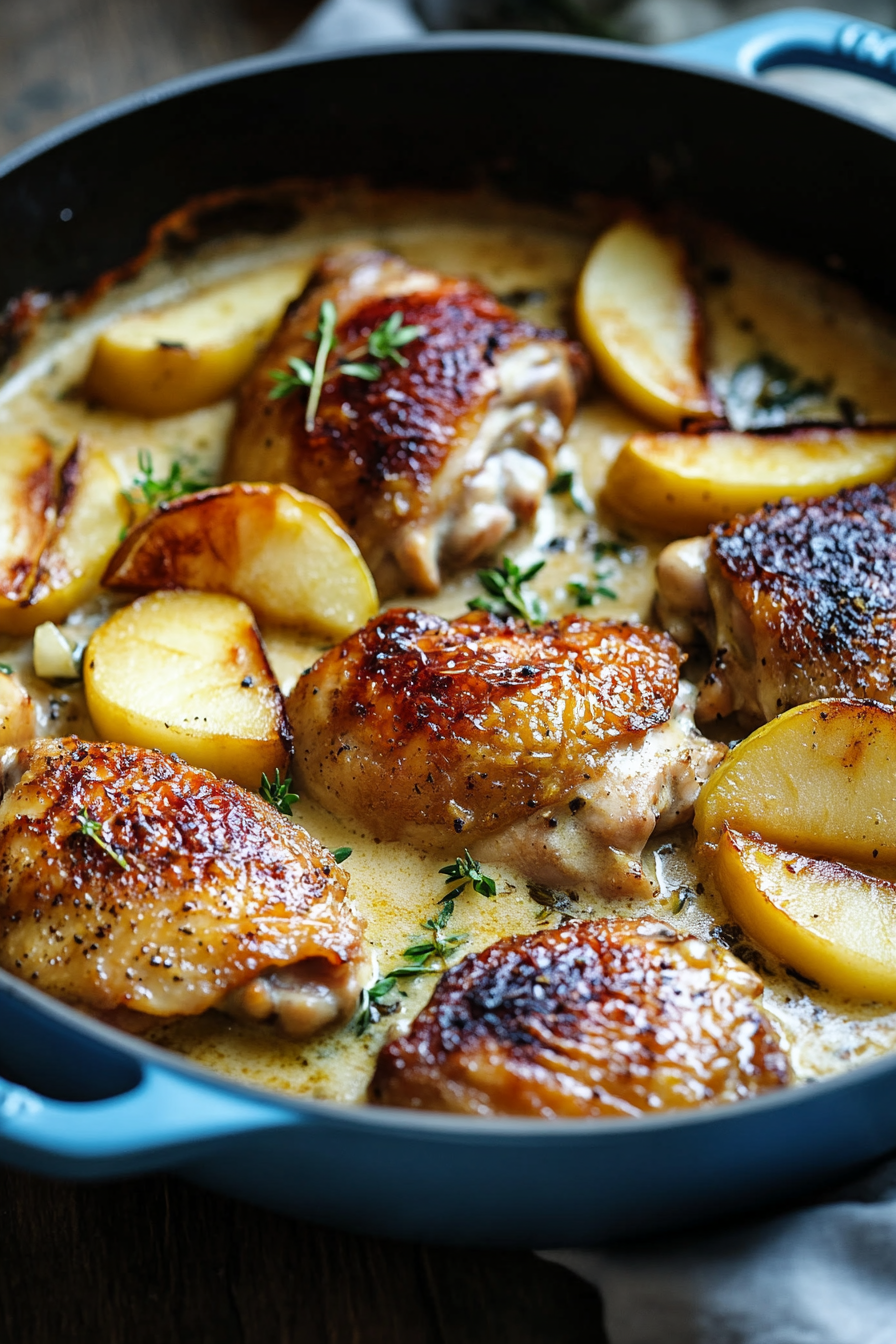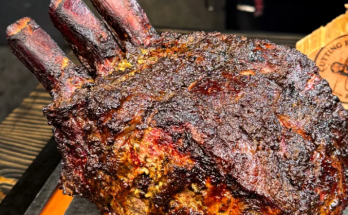Indulge in the essence of fall with Chicken Normandy, featuring braised whole chicken legs in apple cider and brandy, accompanied by onions, garlic, and a creamy dijon mustard sauce, finished with a topping of golden fried apples.

Growing up in a family with deep French roots meant Sunday dinners were an elaborate affair, and Chicken Normandy, or ‘Poulet à la Normande,’ as my grandmother used to call it, held a place of honor. It was her go-to recipe to impress guests or to celebrate the apple harvest. She taught me how to select the perfect cooking apples and the importance of a good-quality brandy. Each step of preparing this dish reminds me of autumn days spent in her warm kitchen, learning the delicate balance of flavors that this dish so masterfully delivers. Now, whenever I miss her or those simpler times, I find myself reaching for the apples and brandy to recreate more than just a meal, but a moment in time.
Why You’ll Love Chicken Normandy
Chicken Normandy isn’t just a meal; it’s a culinary journey to the heart of French cuisine that brings a slice of Normandy into your home with its rich flavors and elegant presentation.
- Rich Flavor Fusion: The combination of apple cider and brandy not only tenderizes the chicken but also infuses it with a complex, sweet-tart flavor that is both grounding and uplifting.
- Creamy Finish: A swirl of cream and a hint of dijon mustard at the end of cooking envelops the chicken in a silky, flavorful sauce that perfectly balances the acidity of the apples and brandy.
- Seasonal Delight: Utilizing apples at their peak seasonality ensures the dish is both fresh and environmentally conscious, supporting local apple orchards.
- Visually Stunning: The golden-brown chicken adorned with caramelized apple slices makes for a visually appealing dish that promises to wow any dinner guest.
- Simplicity Meets Elegance: Despite its luxurious taste and appearance, this recipe is remarkably easy to prepare, making it accessible for both novice cooks and seasoned chefs.
Ingredients Notes
Understanding your ingredients is key to perfecting Chicken Normandy. Here’s a little insight to help you get the best out of your ingredients.
- Butter: Opt for unsalted butter to control the sodium content of your dish, allowing the natural flavors to shine through.
- Apples: Choose firm, tart cooking apples like Granny Smith or Braeburn that hold their shape and add a necessary tang to balance the creamy sauce.
- Brandy: While Calvados is traditional, any good quality apple brandy adds depth and warmth. If unavailable, a good bourbon can substitute in a pinch.
- Apple Cider: Fresh apple cider is preferable for its vibrant apple flavor; avoid sweetened versions to keep the dish balanced.
- Cream: Full-fat cream is recommended for its ability to reduce into a thick, luxurious sauce that coats the chicken beautifully.
Ingredients
- 4 tablespoons of unsalted butter
- 2 cooking apples such as Granny Smith or Braeburn, cored and cut into wedges
- All-purpose flour sufficient for dredging
- 4 whole chicken legs including thighs
- Salt to taste
- 1 large onion peeled and sliced lengthwise into wedges
- 1/2 cup 120 ml of brandy, preferably apple brandy or Calvados
- 2 cups 475 ml of apple cider
- 1 teaspoon of dried thyme
- 1/2 cup of heavy cream
Instructions
-
Preparation of Chicken: Begin by seasoning the chicken legs liberally with salt. Allow them to rest at room temperature for 20 minutes, providing ample time for the salt to enhance the flavors of the chicken.
-
Preheat Oven: Set the oven temperature to 375°F (190°C), ensuring it is adequately heated for cooking.
-
Sauté Apples: In a large, oven-proof sauté pan, melt 2 tablespoons of butter over medium heat. Add the apple wedges to the pan, sautéing until they begin to brown slightly at the edges. Turn the apple slices occasionally to ensure even cooking, and lightly season with salt. Once browned, remove the apples from the pan and set them aside on paper towels to drain.
-
Dredge and Brown Chicken: Coat the chicken legs lightly in all-purpose flour. Using the same sauté pan, add the remaining butter and place the floured chicken in the pan, skin-side down. Cook over medium to medium-high heat until the chicken is golden brown, approximately 3 to 5 minutes per side. Remove the chicken from the pan and set aside.
-
Sauté Onions: Increase the heat to medium-high and add the onion wedges to the pan. Spread the onions in an even layer, allowing them to cook and release moisture, which will help deglaze the pan of any browned bits from the chicken. Continue to cook, stirring occasionally, until the onions begin to brown, about 5 to 8 minutes.
-
Deglaze with Brandy: Pour the brandy into the pan with the onions. Use a wooden spoon to scrape up any browned bits from the bottom of the pan, enhancing the flavor of the sauce.
-
Add Apple Cider and Bake: Once the brandy has reduced by about half, add the apple cider and bring the mixture to a boil. Add the dried thyme and a pinch of salt. Arrange the chicken legs back in the pan, skin-side up, ensuring they are not fully submerged in the liquid. Transfer the pan to the preheated oven and bake, uncovered, for 30 minutes.
-
Finish the Sauce and Serve: After baking, remove the pan from the oven and transfer the chicken to a separate dish. Return the pan to the stove on high heat, add the previously sautéed apples, and reduce the sauce by half. Once reduced, lower the heat, stir in the cream, and season with salt and pepper to taste. To serve, arrange the sautéed apples and onions on a plate, place a chicken leg on top, and spoon the creamy sauce over the dish.
How To Make Chicken Normandy
Mastering Chicken Normandy is all about precision and patience. Here’s how to ensure each step is executed flawlessly for a dish that’s sure to impress.
- Step One: Season the Chicken. Start by generously seasoning the chicken with salt. This not only seasons the meat but also helps to draw out moisture, ensuring a crisper skin when browned.
- Step Two: Prepare for Baking. Heat your oven to 375°F (190°C). This ensures a steady, hot environment for the chicken to cook evenly and develop a beautiful crust.
- Step Three: Brown the Apples. In a large oven-proof sauté pan, melt butter over medium heat and sauté apple slices until golden. This caramelization brings out the apples’ natural sweetness, enhancing the overall flavor of the dish.
- Step Four: Dredge and Brown the Chicken. Lightly dredge the chicken in flour, then brown it in the same pan. This creates a deliciously crispy skin and leaves fond in the pan, which is crucial for building depth of flavor.
- Step Five: Sauté the Onions and Deglaze with Brandy. Sauté onions until they start to brown; then add brandy, using it to deglaze the pan and pick up all the flavorful bits that will enrich your sauce.
- Step Six: Add Cider and Bake. Add apple cider and thyme, then bake. The slow cooking in the oven allows the chicken to become tender and absorb all the flavors.
- Step Seven: Reduce Sauce and Add Cream. After baking, reduce the cider mixture, add the cream, and adjust seasoning. This final reduction thickens the sauce, concentrating the flavors into a rich, creamy coating for the chicken.
Storage Options
Chicken Normandy is best enjoyed fresh, but if you have leftovers, they can be stored in the refrigerator for up to three days. Ensure the dish is cooled to room temperature before covering it and placing it in the fridge. For longer storage, you can freeze the dish for up to two months. When ready to enjoy, thaw it in the refrigerator overnight and reheat gently on the stove to preserve the creamy texture of the sauce.
Variations and Substitutions
While traditional Chicken Normandy is a delight, variations can add a personal touch or adapt the dish to dietary needs.
- Dairy-Free Version: Substitute the cream with coconut cream or a rich nut milk like cashew to maintain the creamy texture without dairy.
- Alcohol-Free Adaptation: Replace the brandy and cider with a combination of non-alcoholic apple cider and a splash of apple cider vinegar to mimic the acidity and depth of flavor.
- Adding Vegetables: For a heartier dish, add carrots and potatoes during the baking stage. They will cook in the flavorful sauce and add an additional texture and taste dimension.
- Herb Variations: Experiment with different herbs such as rosemary or sage for a twist on the traditional thyme seasoning, adjusting to what’s fresh and available.



